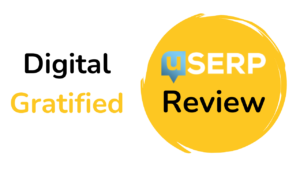You spent months coming up with an innovative idea that will shake the SaaS world. Afterwards, you threw in hundreds of thousands of dollars for product development, distribution, and marketing.
The usual 3-prong process, right? But things went south. The results were totally unexpected.
- Your team has recorded less than ten leads and zero sales so far.
- You’ve done every single thing other SaaS organizations do. But ‘meh’, still nothing.
Out of frustration, you had to consult a few SaaS managers and self-proclaimed authorities in the space. But their little bits here and there didn’t move the needle.
My friend, you need to take a pause there!
Each successful SaaS business has its unique attributes and weaknesses. That means you can’t use Hubspot’s Work Plan and Roadmap to rocket your startup into the moon since your visions and value propositions are different.
Instead, you need a Lead generation strategy – one that can give your business a 101% boost.
In this article, I will thoroughly breakdown what lead generation strategy is. You will also find out how you can create one for your SaaS business, and some bulls-eye steps to generate a constant stream of ready-to-pay leads.
What Is SaaS Lead Generation Strategy?
B2B SaaS lead generation strategy is a well-defined outline that clearly captures the reason why your business exists in the first place, how your product can help consumers, and the steps you need to take in drawing those consumers in.
Let’s breakdown each component below:
- the reason why your business exists in the first place
9 out of every 10 business owners I’ve met believe the main reason their business exists is to make money. That’s not a bad thing actually. However, making money is not the primary reason a business exists.
To be the big boss? Or to sustain a living? They’re all beautiful purposes. And sure, if you run your SaaS business well, you could earn a good return on investment.
But the main reason your business exists is to help consumers. Consumers have problems to be solved, they have pains that need relief, and jobs to be done.
When you look at your SaaS business from this angle, you will find it easier to satisfy your target audience and meet every of their needs. On the other hand, if you look at it solely with the profit-making perspective, there are higher chances you will end up like those failed or bankrupted brands.
- how your product can help consumer
Now that you know your end-users or target customers have jobs to be done, problems to solve, and pain points, how do you plan to be of help?
It’s simple. Your job is to first study their problem and see how your brand can step in as the HERO of the day. I’ve seen some startups who fail to study the market’s problem before rushing into product development.
According to Brian de Haaff, the CEO and co-founder of Aha!, “You must build something that real people with real needs will find value in and pay for — otherwise you do not have a lasting business.”

If you don’t understand what your potential consumers feel or need, there’s no way you can attract them even if your product is the glossiest in the industry.
Your strategy should clearly pinpoints these critical areas and help you build your product into the exact thing people need.
- the steps you need to take in drawing those consumers in
Even after building a product that really fits the bill and provides value, if you don’t get it out there in front of your potential customers, you won’t get a single lead.
That’s why an efficient strategy should contain the steps you are going to take to build awareness for your product and attract leads that convert.
You need to consider the best communication channel to reach your audience, a personalized messaging approach for max response, whether traditional marketing or modern methodology will do the trick, and other contemporary steps to take.
We will explore these steps in later sections.
Here Is How To Create A Lead Generation Strategy That Works (Always!)
Remember we talked about creating a lead generation strategy that’s unique for your business? This is extremely important because what works for company A might not necessarily work for company B.
For instance, Slack focused on using ‘Empathy’ to build a word-of-mouth pyramid, which in turn helped them create a stream of stacking users. Within a few years, they broke the $1 billion market value milestone without spending a dime on traditional advertisement.
Look at Dropbox too. This file hosting and cloud management company spearheaded their marketing campaign with ‘freemium services’. In turn, their customer base spiked up to more than 200 million in less than 6 years.
On the heavy side, these two companies have competitors that rely on spending millions on paid ads to gain traction. It’s not because these competitors can’t copy Dropbox and Slack’s strategies but because they’ve tried to, and it’s not working.
So if you’re going to achieve any profitable success in the SaaS industry, you need to carve out a strategy that works for you alone – and always. And here’s how:
Step 1: Establish Your Business Goals
Business goals are overarching targets you plan to achieve. For a new SaaS startup brand offering a CRM software, the goal could be something like becoming market leader or having the largest base of customers within the industry.
Also, note that goals can be short-term or long-term and general or specific. Short-term goals span across a few hours to a year, and usually, they are extremely specific compared to long-term goals. For instance,
- Reduce customer churn rate by integrating a customer management tool and AI chatbots in the next 6 months.
- Increase user base by going aggressive with promotional campaigns within the next 10 months.
On the other hand, long-term goals take a couple of years, decades, or longer to accomplish. And in most cases, they are more general than specific.
- Become the leading SaaS CRM company within the next 10 years.
- Acquire and cater for more than 20 million B2B clients within the next 5 years.
- Grow revenue by 50% in the next 5 years.
- Expand into 20 more countries within the next 15 years.
Establishing your business goals is crucial to developing an efficient SaaS B2B lead generation strategy because you only know the HOWs and WHEN after you’ve figured out what you plan to achieve.
Goals also serve as reward beacons since they give you a sense of direction and ensure you’re not clueless about what to do next.
However, creating a goal goes beyond just throwing a random business target on the paper and expecting your employees to reach it. You need to use frameworks such as SMART or OKR.
If you go by the SMART framework, your goal must be:
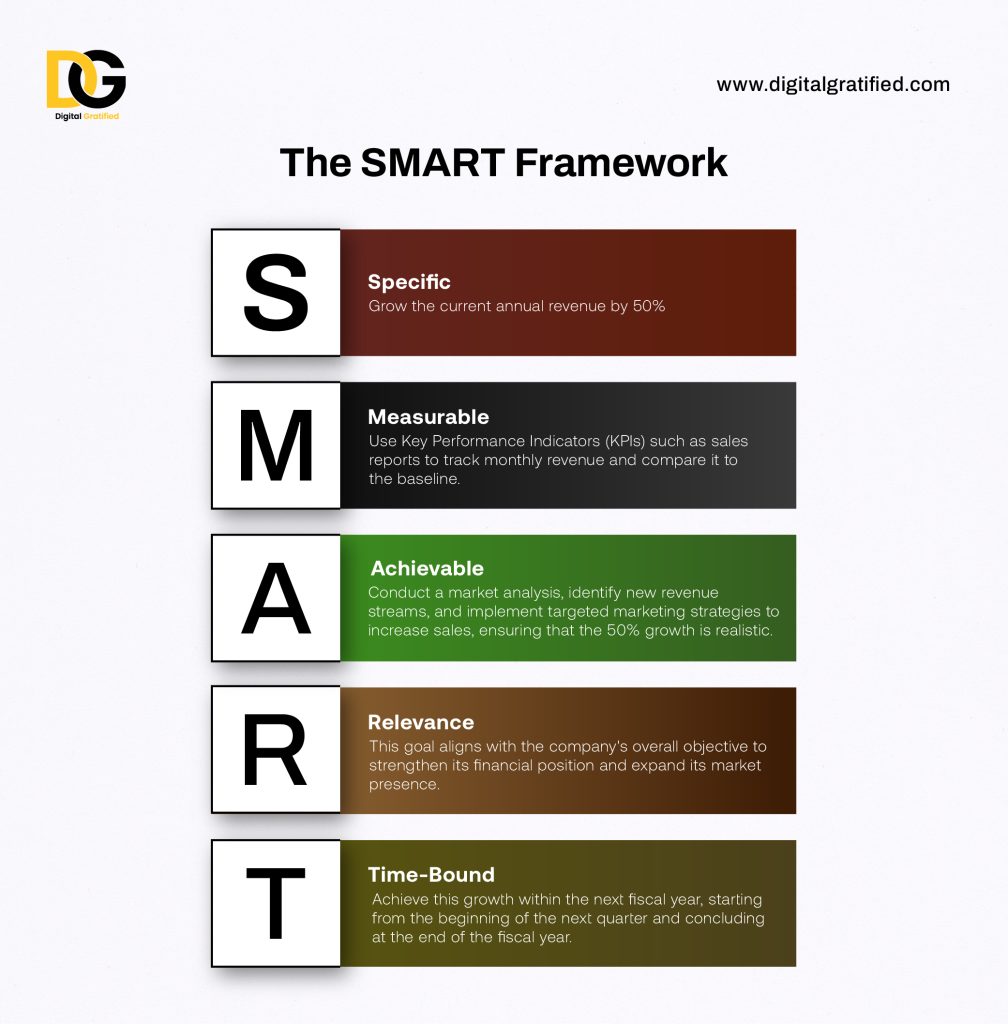
- Specific: Grow the current annual revenue by 50%.
- Measurable: Use Key Performance Indicators (KPIs) such as sales reports to track monthly revenue and compare it to the baseline.
- Achievable: Conduct a market analysis, identify new revenue streams, and implement targeted marketing strategies to increase sales, ensuring that the 50% growth is realistic.
- Relevant: This goal aligns with the company’s overall objective to strengthen its financial position and expand its market presence.
- Time-bound: Achieve this growth within the next fiscal year, starting from the beginning of the next quarter and concluding at the end of the fiscal year.
Other frameworks like Objectives and Key Results (OKRs) can also be used, especially when you’re dealing with a broader market. The objectives represent your organization’s goal at the moment, whereas the key results serve as measurable outcomes that let you know your progress.
An OKR framework should look like this:
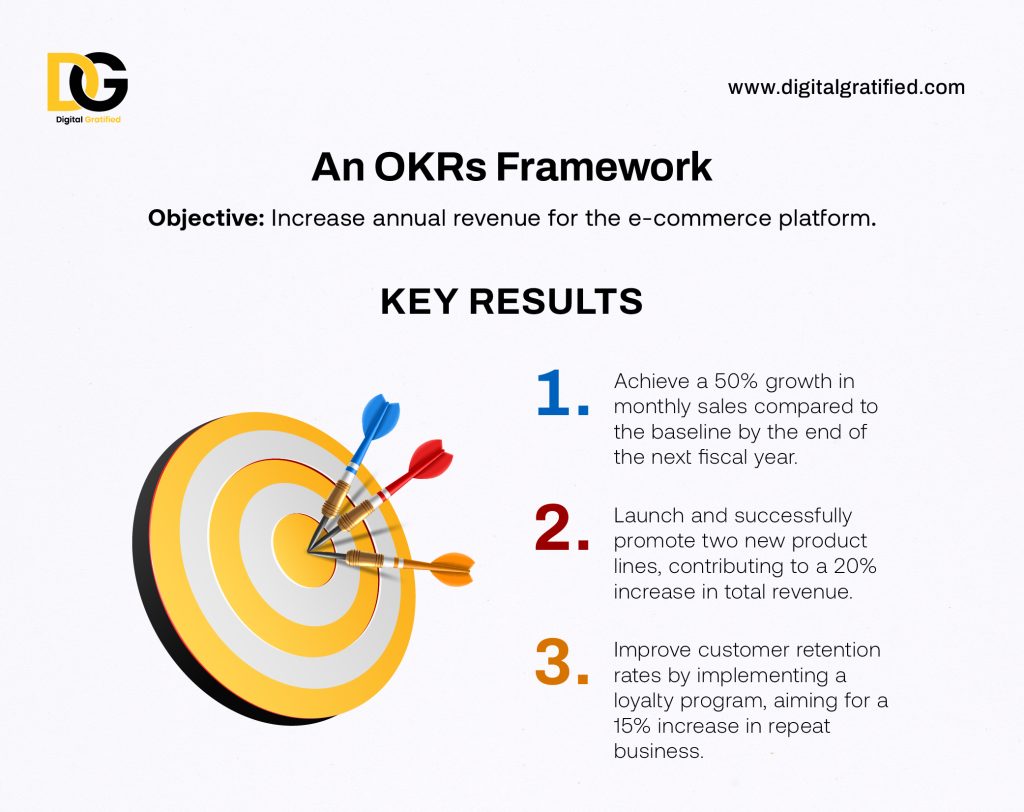
- Objective: Increase annual revenue for the e-commerce platform.
- Key Result 1: Achieve a 50% growth in monthly sales compared to the baseline by the end of the next fiscal year.
- Key Result 2: Launch and successfully promote two new product lines, contributing to a 20% increase in total revenue.
- Key Result 3: Improve customer retention rates by implementing a loyalty program, aiming for a 15% increase in repeat business.
Once you have your goals penned down, then you can take a step further to identify your target audience.
Step 2: Define Your Target Audience And Target Market
Most new SaaS startups mix up target audience and target market. That’s a big mistake because understanding their differences is crucial in shaping up your campaign approach and business strategy.
So, let’s create a few analogies here…
The target market is like a wider fishing net that takes every potential customer into consideration.
- Let’s say you offer healthcare-streamlined CRM software.
- Your target market will be all healthcare organizations ranging from hospitals, labs, nursing homes, and rehabilitation centers to pharmacies.
On the other hand, your target audience is a narrower subset of the existing target market.
- In this case, you’re not trying to provide your CRM software to all healthcare organizations.
- Your primary focus is the hospital sector only.
If we’re to use a non-B2B example, Nike will be a perfect fit. Nike’s target market is everyone that wears shoes – me and you. But their main audience includes females, young athletes, and fitness enthusiasts within the age of 15-40 years.
To define your target audience and market, you need to first figure out what unique problems your product can solve.
Afterward, find out people who have these problems by rolling out a survey, discussing with previous customers, if any, and analyzing your competitors.
Your survey should at least collect the following information:
- Demographics: Age, gender, location, education level.
- Occupation and Industry: Job roles, industry sectors.
- Challenges and Pain Points: Problems they are trying to solve, pain points they experience.
- Communication Preferences: How they prefer to be communicated with, preferred content types.
- Behavioral Insights: Buying habits, technology usage, brand preferences.

It’s also quite important to prioritize your audience’s communication preference as this helps you send your campaigns in the right direction and connect with potential customers on the appropriate platform.
For instance, a SaaS startup offering email marketing software will best connect with industry professionals who need automation for their email marketing services on LinkedIn than on Instagram.
At the same time, you need to create a buyer’s persona. This persona gives you a holistic view of your ideal audience and helps you create more personalized messaging.
Step 3: Analyze Existing And Upcoming Competitors
I remember back then in high school when all we had to do was wait for the ‘intelligent’ students to complete their assignments while we did the copying after. That was an easy way out and saved us time – especially the lazy ones.
But hey, you’re not trying to take the position of a ‘lazy’ business owner here. The plan is to analyze your competitors, not copy.
First off, most of your competitors have been in the game for years and possibly decades. This ultimately means they’ve found a strategy that works perfectly for them.
And here’s how to dig them up:
Classify Your Competitors
Competitors can be direct or primary and indirect or secondary. The direct competitors are those that offer the same product and services as you and target the same customers in your region. A perfect example is Coca-Cola and Pepsi-Cola.
As for the indirect competitors, they offer different product but target the same customers. For instance, Nestle’s main product is coffee, which targets the same audience or customers as Coca-Cola.
Knowing who your direct and indirect competitors are is a good way to figure out who their target audience is.
Let’s say Hubspot, a CRM SaaS company, is your direct competitor. All you need is a couple of internet research to know who they target. And if you want to know where most of their leads come from, you only need to hire a digital agency offering SaaS SEO services to conduct an SEO analysis on Hubspot’s website. That’s all!
Know Their 4 Ps
Once you’ve figured out your direct and indirect buddies in the market, the next thing to do is breakdown their 4 Ps and see if there’s any opportunity to leverage.
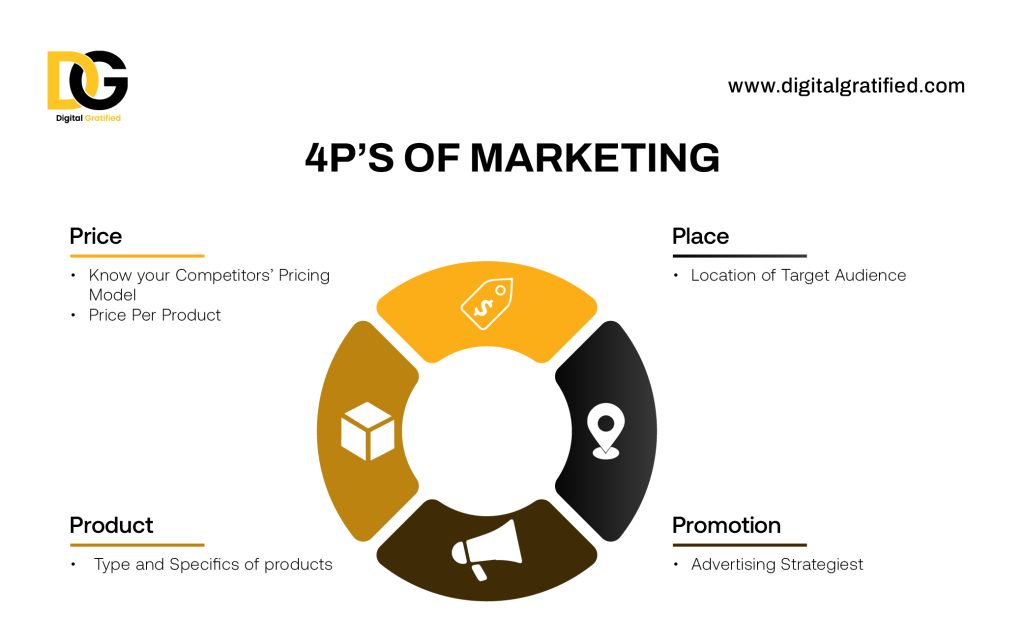
- Product: You need to know the type and specifics of products offered by your competitors. Yes, we know they provide the same SaaS software as yours. But there must be a unique point in their software that makes it stand out in the market among others.
- Price: Know your competitors’ pricing model, price per product, and other non-sale costs. If their pricing is way too much, that might be a loophole for you to exploit.
- Place: There are tons of marketing channels, but your competitors must have a particular place where their products gain more providence. For instance, a SaaS CRM company will gain more leads from LinkedIn than from Instagram.
- Promotion: Double down on their advertising strategies, what they do differently, how they do it, and where.
Do A SWOT Analysis
SWOT means Strength, Weakness, Opportunity, and Threats. When doing a SWOT analysis, you need to ask questions like:
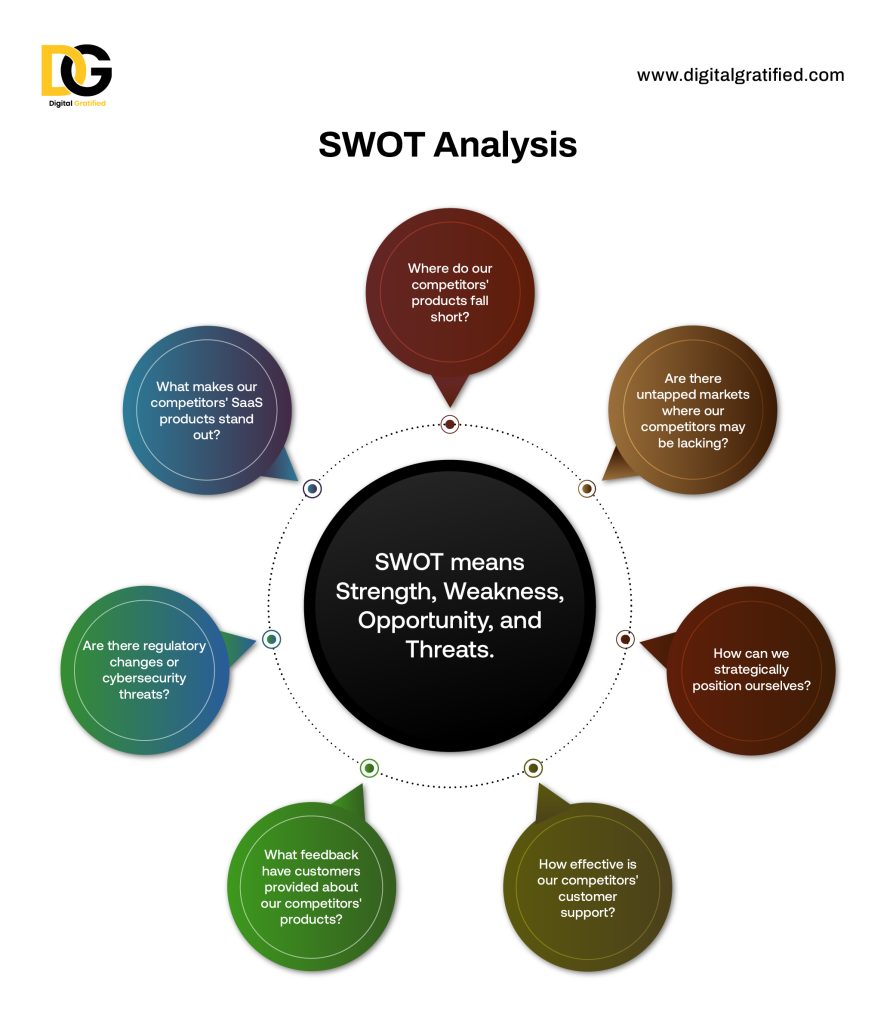
- What makes our competitors’ SaaS products stand out?
- Where do our competitors’ products fall short?
- How can we strategically position ourselves to outperform our competitors in adapting to market trends and evolving customer needs?
- Are there untapped markets where our competitors may be lacking?
- How effective is our competitors’ customer support?
- What feedback have customers provided about our competitors’ products?
- Are there regulatory changes or cybersecurity threats that could impact the stability and performance of our competitors’ SaaS products, and how can we proactively address or mitigate these threats for our own strategic advantage?
Step 4: Choose A Lead Generation Channel(s)
Lead generation channels refer to both platforms you can use to generate and convert leads. These include primary channels like your website, social media, landing pages, and advertisements.
Now the thing is, most of the existing SaaS businesses out there use two or more channels. That’s not a problem. Afterall, a rule of thumb in the marketing world is to use multichannel marketing to help you tap into various lead generating opportunities.
However, investing in every channel without understanding which one works and which one doesn’t, is one of the fastest route to bankruptcy and startup failure.
So instead of jumping straight at the gun, do these:
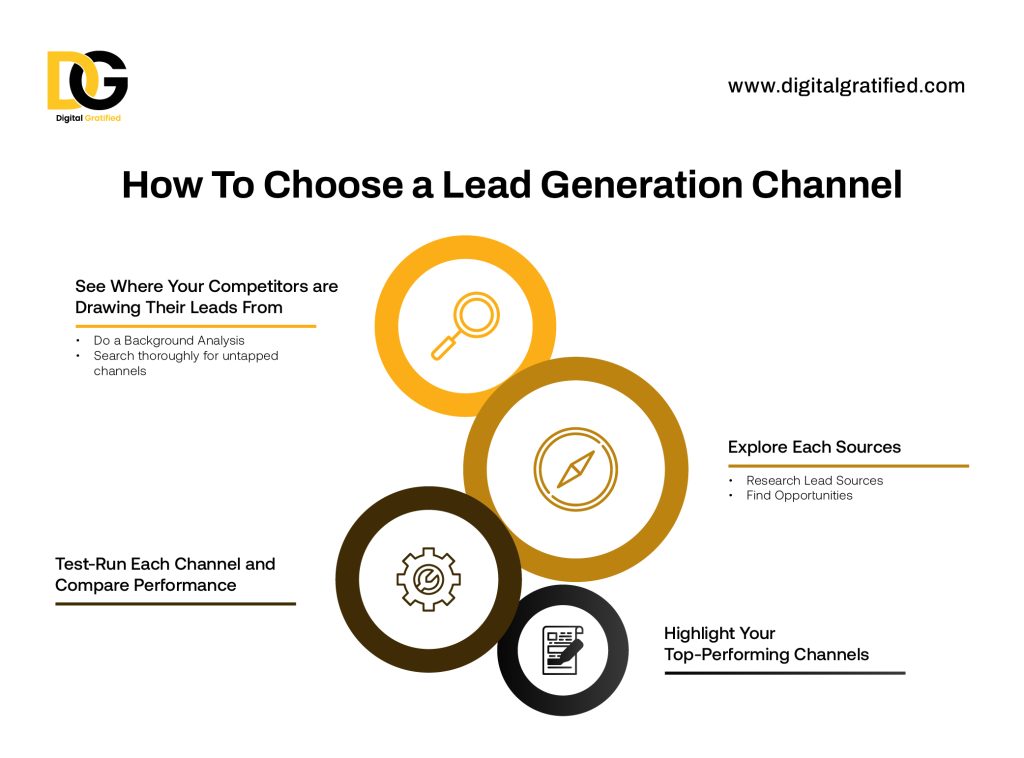
See Where Your Competitors Are Drawing Their Leads From
First things first, do a background analysis and find out where your competitors are getting their leads from. Don’t just focus on the channels giving them high yield leads only. Also look at the lead sources they are undermining and see if you can tap into an unexpected opportunity there.
Do More Digging Into Each Source
Your next task is to research each lead sources or channels and estimate how much money you need to pump in to get a good result. Find out if there are opportunities you can exploit and if you can actually reach your target audience through the channels.
Test-Run Each Channel And Compare Performance
Once you have a list of potential channels, you need to test-run each of them and measure both short-term and long-term results. For instance, you can compare the results you get from Instagram to LinkedIn over a year. Or see if product comparison articles draw in more leads than topical authority topics on your website’s blog.
Highlight Your Top-Performing Channels
By now, you should know which channel is doing well or less. But the goal is not to dump those lead sources that have little yield. Instead, see why they are underperforming and how you can make the best out of them with the least investment.
Step 5: Summarize Your Strategy
So far, we’ve figured out four things:
- Your business goals
- Target audience and market
- Competitors’ profile, marketing channels, strategies, and SWOT.
- Top and Least performing channels for your SaaS business
Summary of these four critical knowledge panels make up your lead generation strategy and serves as a lens to helping you choose the right lead generation channels and techniques. To understand what I mean, consider the two analogies below.
Let’s say two of your competitors, A and B, offer their SaaS product at $10,000 per monthly subscription. Besides promoting your product on relevant channels and doubling down on SEO efforts, you can also reduce your pricing to something like $9500 or less (so long as it doesn’t affect your profits). That’s called price bait, and if done well, you should see a good spike in your leads traffic within months.
Or imagine finding out that your competitors provide poor customer support service. You can leverage this knowledge to improve your customer support team and use it as a front in your advertisements to draw in more leads.
Step 6: Review Continuously
Nothing changes more than a customer’s preferences and needs. And these changes ultimately affects your lead generation strategies whether you like it or not. But it’s not only customer’s preferences and needs that change.
For instance, billboards and prints were the major icons decades ago. Most businesses like Coca-cola used these traditional approaches as their main lead generating approach. But what about now?
Coca-cola has evolved its strategy into a hybrid one using both traditional and modern lead generation channels – with the latter taking more precedence.
So technically, you need to review your strategy everytime to see if it can still help you achieve your marketing goals while also satisfying your customers. Update the channels you use with time, and always be on the waitlist to try out newer channels too.
17 Proven Ways To Generate Leads That Convert (Plus Examples)
There’s no one-channel-fits-all when it comes to lead generation for SaaS companies. So while your website might be drawing in significant leads for you, there are still multiple other channels and methods you can exploit for more returns.
Let’s quickly go through each.

1. Integrate Freemium Plans With Referrals
People love free things. And that’s why most SaaS companies offer basic features of their products at no cost through a model called freemium pricing. If users require advanced features, then they can pay a fee for an upgrade.
Freemium pricing is the perfect way to take potential customers on a free ride while you display your unique product offerings and entice them to take a step further. Now imagine combining it with a referral program like Dropbox did (case study below).
Of course, using the freemium model plus referrals might take a toll on your revenue in the first few years. But if you do it right and build a relevant customer base, you can become of the industry dark horses like Dropbox.
DropBox
Dropbox is a remote-storage American company founded in 2007 Drew Houston and Arash Ferdowsi. This company offers a file hosting service and provides users access to cloud storing facilities. In order to build their customer base, they offered a freemium subscription with a storage cap of 2 Gigabytes. Once exceeded, users had to pay for an upgrade.
But here’s the catch. Dropbox introduced a referral program with their freemium. Anytime you refer another user, you and the new user will receive additional 500MB to 1GB space.
With this hybrid model, Dropbox grew their customer base to 200 million plus in 6 years, and now, they have up to 700 million users with estimated $1.91 billion in 2020 alone.
2. Build Trust With Customer Reviews And Testimonials
Approximately 99.9% of customers say they read reviews about a product or service online before making their purchase sometimes. In the same survey, reviews and ratings were chosen as the foremost decision influencers compared to other factors like pricing.
Forget the stats above. There are 2 in 3 chances that you check the number of star ratings and reviews a product has when you visit Amazon for black friday shopping. And the main reason is because you want to know if the product supplier is trustworthy or if the product quality meets the mark.
So by experience, anytime you see a product without reviews, ratings, and or testimonials, you’re more likely to press the skip button and move on to the next. If you can do that, then your customers can also do the same to you.
Way out? Collect text and video reviews from past clients, friends and families, and beta product testers. Upload them on your website, paste on the homepage, and use for your promotional advertisements.
What About Negative Reviews?
Most SaaS industries are in the habit of keeping good reviews and ratings of 5.0. I get it – negative reviews can mar your service record and look like a red flag to incoming leads.
But plastering only the 5.0s on your web pages screams “scam” and “untrustworthiness”.
Instead, use the 95–5% rule. 95% of reviews should feature the good reviews, 5% should feature the not-so-good but not-so-negative reviews. This assures your customers that they are dealing with a truthful organization – and not the ones who are only interested in putting up a fake front.
3. Host Webinars, Virtual Events, And Conferences
In a survey, 95% of companies use webinars as an integral part of their marketing strategy. 87% of them host approximately 150 webinars a year. 5 to 20% of their webinar attendees eventually become hot leads and can easily convert to become a buyer.
But that’s not all! The market share of meetings like webinars, virtual events, and conferences is projected to reach a whopping $5 billion in 2035. That’s a testament to how much companies are willing to invest in webinars and other meetups.
One thing about webinars and the likes is that you’re not trying to appear sale-sy or promotional. What you’re providing is a pure, educational content while presenting yourself as an authority in the industry.
Doing this puts you at the topical focus of your webinar attendees, helps you prequalify leads, and increases your SaaS product’s awareness.
Virtual Vs. Physical Events
There’s a long standing competition between virtual events like webinars and physical conferences. Anyone is fine depending on your target audience, geo-graphical location, and goals.
For instance, if you’re offering a local SaaS product, using a physical conferencing method will prove more effective so long as you can convince people to come. But if your product caters to other companies globally, you definitely can’t expect someone’s who the key decision maker in his organization to travel over just because they want to hear you speak.
4. Join Other SaaS Communities And Collaborative Platforms
It’s a common misconception that SaaS brands only serve non-SaaS businesses. You should know by now that a CRM company can provide its software to another SaaS company providing an entirely different SaaS product.
That means both SaaS and non-SaaS organizations are your potential customers.
So the best find platforms where some of the top brands, fitting into your audience, gather. If you’re not sure of how these platforms look, here’s one organized on Meetup.
There are many others with different group statements and so on. Just hit the internet, particularly social media platforms like LinkedIn, and search for SaaS communities
5. Go Targeted And Personalized With Paid Ads
Promotional ads shouldn’t be a new thing to you by now. If you’re just starting up, you might need to throw in a bit of cash to gain your first customers. When that happens and you have enough reviews, generating organic leads becomes a tad easier.
However, you have to ensure your ads are personalized and targets the right segment of audience. We talked about target audience and market before. Your audience includes the exact demographics your ads were created for.
To create a personalized ad, you need a buyer persona. This will help you advertise the pain of your audience, put out your solutions, and nudge leads to click the green button.
Adidas Liquid Billboard
Adidas is a sportswear and apparel brand, a direct competitor of Nike. In order to scale their new swimwear collections, the company created the world’s first liquid billboard that featured dozens of women from 60 countries of different races and colors.
Their aim was to encourage more women to feel comfortable swimming out in the public. This was their audience’s pain point, and that means simply promoting a swimwear wouldn’t have been effective.
So Adidas advertising strategy was to address the pain point while featuring their swimwear as an inconspicuous, but essential element of courage. The result was monumental and beyond effective.
6. Create A Blog Page And Quality Content For SEO
Your website is not just a digital showglass – it’s also there to attract leads organically and send them down your conversion funnel. But nothing as such will happen if you don’t add a blog page to it. See how Hubspot and Mailchimp did theirs.
Once you have a blog section, curate a list of topics that primarily focuses on your product’s area of expertise. Let’s say your company offers an email marketing software. Then your primary topics or pillar pages should be on email marketing.
Other topics like content marketing, social media marketing, and so on can fit in as secondaries.
Besides choosing the right topic, get a content team consisting of writers, editors, and an SEO to ensure a consistent production of quality articles. Your writers and editors should understand the company’s value proposition, target audience, and have a wealth of experience handling the topics assigned.
All these measures is just to ensure your blog content ranks high on social media. And the higher you rank, the more leads you’re likely to generate (especially if you’re on the frontpage).
7. Launch Your Product For Beta Testing
Most companies launch a pre-testing phase for their products, including the likes of Google when it rolled out Bard.ai. The essence of beta testing is to figure out bugs and errors in your product before releasing it to the public.
However, beta testing doesn’t just serve a pretesting function. The first group of people who do the testing are more likely to become your first customers since they had the first contact with your SaaS product.
Also, beta testers are the perfect set of people for using word-of-mouth and referral marketing. Of course, this comes with an incentive such as an extended subscription after the testing ends. ContactOut, an email marketing service with a knack for cold emailing does this occasionally.
8. Leverage Social Media
There are currently about 4.95 billion social media users, with over 3 billion user visits on Facebook monthly. LinkedIn alone has close to 900 million users from more than 200 countries and tails behind other platforms like Whatsapp.
The stats go on and on to show how powerful social media is. While not all the 4.95 billion users are your target audience, the little 1% that belongs to you is not a trifling figure. That’s why even top brands like Hubspot, Slack, Shopify, and Hootsuite invest heavily in social media marketing.
When leveraging social media, you have to choose the right platform to start with. For instance, establishing dominance on instagram as a CRM SaaS company wouldn’t do you any good. Instead, you should direct your efforts to LinkedIn and Facebook where there are more of industry leaders and decision makers.
Create educating social media posts consistently to build yourself as a go-to authority. Moreover, the more you post through your company’s page or personal account, the more the algorithm of platforms like LinkedIn will showcase your profile to potential clients.
9. Run UGC Campaigns
UGC or user-generated content means authentic content created by customers to showcase a product or brand.
This is more or less the same thing as taking a shot of your KFC order with one chicken leg hanging outside and posting it on social media to make your followers drool. When you add a public hastag like #kfcchicken, you’ve automatically campaigned for the company behind.
Why does this work? Well, people are more likely to trust reviews and posts concerning a brand if it’s coming from someone who shares the same pain points or from fellow customer like them.
To create a UGC campaign, you can tell existing users to share their positive views about your product on social media with a designated hastag. Of course, not everyone will love to participate in such. That’s where incenticising your campaign comes in. Reward the best UGC or top 5 with extended susbcription, discounts, additional product features, or anything that will make them hop on the trend.
Starbucks UGC Campaign
Starbuck, a company chain of coffeeshops, launched a UGC campaign with the hashtag #WhiteCupContest in 2014. Customers were asked to cook up artistic and creative arts on a white cup and post on their social media account.
Drawings that best aligned with the company’s vision statement and value proposition were chosen as the next line design templates for starbuck’s coffee cups. This campaign saw tens of thousands of participation and took the brand’s awareness to another level.
10. Use AI And Chatbots
Integrating intelligent chatbots with marketing channels is the current trend in the SaaS world because it reduces recruitment cost and increases productivity. But they can also help you generate leads if you use them right.
For instance, anytime someone clicks on your website’s chatbox, your AI bot can prompt them to drop some personal details like email and number before requesting their complaints. These data are extremely useful for cold marketing purposes, with appropriate permission of course.
At the same time, AI bots can upgrade your customer support service and ensure your existing customers go home with a good experience. This facilitates positive review and increases the possibility of people sharing your product with others.
11. Personalize Your Emails
There are currently about 4 billion people using emails as a communication method, whereas 41.5% of brands believe email marketing is crucial to their success.
Interestingly, an average person checks his email app at least twice a day. And if you’re like me, the real figure will be at least fifteen times daily.
With this much users, it’s no wonder emailing has held up against social media channels till now.
But achieving success with email marketing is not as simple as it looks. You’re either battling with an extremely low open rate or wondering why your CTR is so low despite hiring the best email copywriter.
So what’s the trick to getting good results? Email Personalization!
We’re already past that age where you address your email subscribers plainly with “Hi” or “Hello”. Your emails shouldn’t be without humor or age, as that will only make your leads unsubscribe instead of converting.
At the same time, do not approach your email subscribers as a company. That’s way too much and creates an uncomfortable feeling.
For instance, compare getting an email from these two addresses – support@adobe.com vs harley@adobe.com.
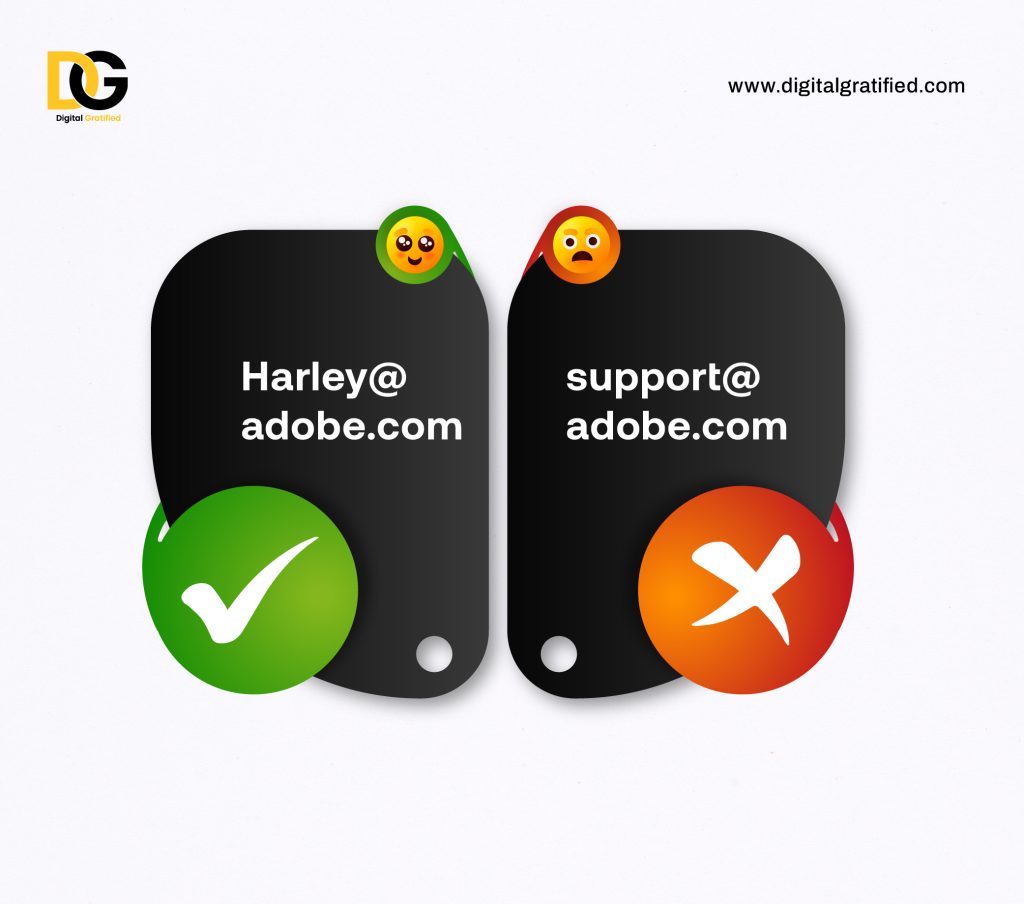
There’s no doubt you’ll go for the second. It’s more personalized.
12. Prioritize Website SEO (On-Page SEO, Technical SEO, etc.)
Do you know 91.5% of Google’s traffic stays on the frontpage? And the first website takes about 28.75% of all the clicks or leads coming from this 91.5% traffic. That’s why the competition to rank higher on SERPs is quite a tough one especially for startups without any traction.
If you want to rank on Google’s frontpage, it is essential that you optimize your website for search engines. People should be able to search relevant keywords like “email marketing software” on the internet and see you pop up on screen immediately.
Otherwise, you’ll often end up on the 100th position out of a million others.
So start your SEO by running a technical audit to see what issues drag down your website. Eliminate factors that reduce page loading speed and eliminate bugs that can worsen user experience. You also need to put your website’s aesthetic into consideration. Ensure the design is good for eyes and reflect your brand’s values.
Asides optimizing your homepage and blog, you should also invest in link building. No matter how good your content and website is, if you don’t have quality backlinks, you will find it extremely difficult to leave a mark on SERPs.
Of course, you don’t have to build the links yourself. Leave the hardwork to us at DigitalGratified and see how your website spikes up in ranking within a few weeks. You can check out how much that will cost you by using our link building cost calculator and SEO cost calculator.
13. Contract Industry-level Influencer Marketers
This is one high-level lead generation strategy that most SaaS businesses ignore. Influencers are people with a large, loyal follower’s base. And their main task is to hype a product while recommending it to followers. That sounds like what B2C businesses need, but B2B SaaS brands can take good advantage of it too.
Put an illustration here to show how influencers spread product awareness.
There are tons of social media influencers on platforms like LinkedIn with a wealth of knowledge, authority, and social media fan base. By casually making a shoutout to your brand, they can increase lead flow and boost awareness.
If you’ve not seen on before, check out Aaron Ross and Jason Lemkin among many others on LinkedIn. Even Elon Musk or Warren Buffet can influence your product. It all depends on what you can offer them in return.
Literally, anyone with a good number of followers and deep understanding of your niche can do the job if you throw an offer.So don’t be fixed on getting someone with an “influencer” caption on his or her status.
14. Proactively Engage Potential Clients With Cold Marketing
Cold marketing involves reaching out to customers who have not shown interest in your product before but fits into your buyer persona. This is the exact opposite of warm marketing where you engage leads that have had initial contact with your brand or product.
In cold marketing, you can either cold email or cold call your prospects. But to do that, you need to have their contact details first. You can easily get that by scraping social media platforms with tools like LinkedIn Sales Navigator and Octoparse.
Scraping emails can, however, be a tiring thing to do. Moreover, you might not be able to confirm if the contacts in your list are active or dead. This increases your risk of getting banned by email servers.
Alternatively, you can buy premade lists from brands such as BookYourData and LeadPlease. From there, you can start reaching out to each contact via email or call. While the open rate of cold emals is only 23.9%, that’s more than enough to convert a dozen high-yield leads.
15. Integrate Virtual Reality For Exciting SaaS Marketing Experiences
The modern world is filled with all sorts of innovation with virtual realities taking one of the star peaks. You can literally see more and more people adorning their VR headsets to face off some unreal boss in a gaming scenario.
However, VR is not all about games. Some businesses have started using virtual reality to launch awesome product advertisements that are too difficult to ignore.
But you shouldn’t limit yours to running ads only. Use VR to host product demos and walk hot leads through a captivating journey highlighting your product features step by step.
While this approach definitely won’t reach all your target audience, it can at least increase the chances of retaining the few it reaches.
16. Create Case Studies And Host Podcasts To Build Topical Authority
Case studies are concise pieces that describes a customer’s problem, how you solved it with your product, and the current, measurable results. First off, case studies are extremely convincing and can give your leads the little push they need. Secondly, leads that have read one or two case studies are much easier to convert.
To get interesting case studies, you should interview your previous and existing clients. Don’t force it if they’re not too comfortable with publicizing their details. But you can offer incentives wherever necessary.
Similar to case studies, you can use podcasts to discuss how you scaled a business from zero to hero. People want to hear how you did and if you can do the same for them. Also speak on topics that are relevant to your offerings while positioning yourself as an industry leader worthy of trust.
An additional tactics is to invite other industry leaders to make a stand on your podcast. This is a way to boost your popularity and indirectly push your brand to the stage more.
17. Use Pop-ups With Ebooks To Create Lead Magnets
Unlike the traditional method of buying email lists or scraping from social media platforms, you can use lead magnets to directly and legally collect contact details from your leads without breaking a sweat.
Here’s the process. You create a pop-up on pages or blogs with most visits. Anytime a reader scrolls past a section, they get the pop-up which asks them to input their contact details in exchange for a reward – usually knowledge ebooks.
Of course, you can’t just plaster your pop-up with “give me your details and i will give you my book. Instead, you should use something like “Grab A Copy Of The 10 Secrets We Used To Scale Hubspot From 0 to $10million revenue monthly”. Windy, but that’s just a reference.
Check out Appsumo’s lead magnet below.
Conclusion
We’ve gone all high and low on lead generation strategies that you can use to scale your SaaS business. But what’s more important is finding the right button.
Importantly, prioritize your website SEO. That’s your first source of leads if you set things right, and it will always be your primary lead channel.
If you’re having trouble doing your SEO or building links, that’s no problem. At DigitalGratified, we create an SEO framework and build quality links for SaaS businesses like yours.







